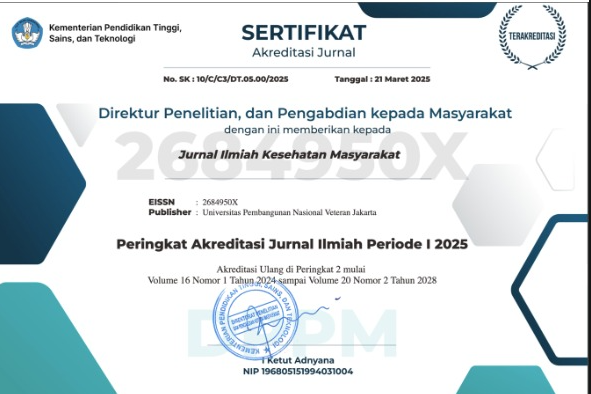Cedera Akibat Kecelakaan Lalu Lintas di Indonesia: Faktor Risiko Serta Strategi Pencegahan dan Intervensi
Abstract
Abstrak
Cedera akibat lakalantas masih menjadi masalah kesehatan masyarakat yang besar, baik di Indonesia
maupun di dunia. Angka kematian akibat lakalantas terus meningkat setiap tahun seiring dengan pertambahan jumlah kendaraan bermotor. Namun, angka cedera dan kematian lakalantas di Indonesia sangat sulit untuk ditentukan secara pasti karena ketiadaan sistem surveilans terintegrasi. Para pengendara sepeda motor dan pejalan kaki digolongkan ke dalam kelompok berisiko tinggi. Terdapat beberapa faktor yang dapat meningkatkan risiko cedera dan kematian akibat lakalantas, yaitu faktor risiko pengendara, kendaraan, dan lingkungan. Mengenai faktor risiko pengendara, terdapat faktor perilaku, status kesehatan pengemudi, dan faktor-faktor yang tidak dapat dimodifikasi. Berdasarkan literatur yang diperoleh, perilaku tidak mengenakan helm, tidak menggunakan sabuk keselamatan, kebiasaan mengebut, konsumsi alkohol, penggunaan ponsel saat berkendara, kelelahan dan kantuk, serta usia muda dan pria dapat meningkatkan risiko cedera akibat lakalantas. Mengenai faktor kendaraan, kendaraan berusia tua dan tidak diperiksa secara rutin menjadi faktor risiko. Terkait faktor lingkungan, keberadaan persimpangan jalan, kondisi jalan rusak atau di bawah standar, serta keadaan matahari terbit, terbenam, dan malam hari meningkatkan risiko lakalantas yang menyebabkan cedera. Sebagai solusi, Pemerintah Indonesia perlu melaksanakan strategi pencegahan dan intervensi yang diadaptasi dari WHO, yaitu lima pilar sistem keselamatan jalan. Lima pilar ini terdiri dari pengelolaan keselamatan jalan, jalan dan mobilitas yang lebih aman, kendaraan yang lebih aman, penggunaan jalan yang lebih aman, dan respons pascalakalantas. Komunikasi dan kolaborasi yang kuat antarlembaga negara juga pihak-pihak terkait sangat diperlukan untuk menyelenggarakan strategi pencegahan dan intervensi cedera akibat lakalantas.
Road Traffic Injury in Indonesia: Risk Factors, Prevention and Intervention Strategies
Abstract
Road traffic injury remains a major public health issue in both Indonesia and the world. Traffic-related death rate continues to increase each year along with the growing number of motor vehicles. However, in Indonesia, road traffic injury and fatality rates are difficult to determine due to the lack of an integrated surveillance system. Motorcyclists and pedestrian are classified as high-risk groups. Several risk factors which can increase traffic-related injury and death risks include driver, vehicle and environmental factors. Driver risk factors consist of behavioural factors, driver’s health status and factors which cannot be modified. Numerous sources suggest that not wearing a helmet or safety belt, speeding habit, alcohol consumption, mobile phone use while driving, fatigue and sleepiness, young age and male may increase the risk of road traffic injury. Vehicles which are old and not inspected regularly appear to be a risk factor as well. Regarding environmental factors, urban junctions, damaged or substandard roads, sunrise, sunset and night time raise the risk of traffic accidents leading to injuries. To address these problems, the Indonesia government requires to implement prevention and intervention strategies adapted from WHO, namely five pillars of a road safety system. These include road safety management, safer roads and mobility, safer vehicles, safer road users and post-crash response. Strong communication and collaboration efforts involving government institutions and related parties are needed to carry out road traffic injury prevention and intervention measures.
References
WHO. Global Status Report on Road Safety 2018. Geneva: World Health Organization; 2018.
WHO. Road Traffic Injuries Geneva: World Health Organization; 2018 [Available from:
https://www.who.int/news-room/fact- sheets/detail/road-traffic-injuries.
Kemenhub RI. Perhubungan Darat dalam Angka 2013. Jakarta; 2014.
Kepolisian RI. Jumlah Kecelakaan, Korban Mati, Luka Berat, Luka Ringan, dan Kerugian Materi yang Diderita Tahun 1992-2017. Jakarta; 2019.
Undang-undang Republik Indonesia Nomor 22 Tahun 2009 Tentang Lalu Lintas dan Angkutan Jalan, (2009).
WHO. Global Status Report on Road Safety 2015. Geneva; 2015.
Peraturan Menteri Pekerjaan Umum Nomor 03/PRT/M/2014, (2014).
Abbas AK, Hefny AF, Abu-Zidan FM. Does wearing helmets reduce motorcycle- related death? A global evaluation. Accident Analysis & Prevention. 2012;49:249-52.
WHO. Helmets: A Road Safety Manual for Decision-Makers and Practitioners. Geneva: World Health Organization; 2006.
Vorko-Jović A, Kern J, Biloglav Z. Risk factors in urban road traffic accidents. Journal of Safety Research. 2006;37(1):93-8.
Valent F, Schiava F, Savonitto C, Gallo T, Brusaferro S, Barbone F. Risk factors for fatal road traffic accidents in Udine, Italy. Accident Analysis & Prevention. 2002;34(1):71-84.
Bener A, Burgut HR, Sidahmed H, Al- Buz R, Sanya R, Khan WA. Road Traffic Injuries and Risk Factors. Californian Journal of Health Promotion. 2009;7(2):92-101.
Stübig T, Petri M, Zeckey C, Brand S, Müller C, Otte D, et al. Alcohol intoxication in road traffic accidents leads to higher impact speed difference, higher ISS and MAIS, and higher preclinical mortality. Alcohol. 2012;46(7):681-6.
Petridou E, Moustaki M. Human factors in the causation of road traffic crashes. European Journal of Epidemiology. 2000;16(9):819-26.
Sethi M, Heyer JH, Wall S, DiMaggio C, Shinseki M, Slaughter D, et al. Alcohol use by urban bicyclists is associated with more severe injury, greater hospital resource use, and higher mortality. Alcohol. 2016;53:1-7.
Asbridge M, Brubacher JR, Chan H. Cell phone use and traffic crash risk: a culpability analysis. International Journal of Epidemiology. 2013;42(1):259-67.
Robb G, Sultana S, Ameratunga S, Jackson R. A systematic review of epidemiological studies investigating risk factors for work-related road traffic crashes and injuries. Injury Prevention. 2008;14(1):51-8.
Connor J, Norton R, Ameratunga S, Robinson E, Civil I, Dunn R, et al. Driver sleepiness and risk of serious injury to car occupants: population based case control study. BMJ : British Medical Journal. 2002;324(7346):1125-.
Kementerian Kesehatan RI. Petunjuk Teknis Pemeriksaan Deteksi DIni Faktor Risiko Kecelakaan Lalu Lintas bagi Pengemudi. Jakarta: Direktorat Jenderal PP & PL; 2015.
Santamariña-Rubio E, Pérez K, Olabarria M, Novoa AM. Gender differences in road traffic injury rate using time travelled as a measure of exposure. Accident Analysis & Prevention. 2014;65:1-7.
Rechnitzer G, Haworth N, Kowadlo N. The Effect of Vehicle Roadworthiness on Crash Incidence and Severity. Melbourne; 2000.
Blows S, Ivers RQ, Woodward M, Connor J, Ameratunga S, Norton R. Vehicle year and the risk of car crash injury. Injury Prevention. 2003;9(4):353- 6.
Blows S, Ivers RQ, Connor J, Ameratunga S, Norton R. Does periodic vehicle inspection reduce car crash injury? Evidence from the Auckland Car Crash Injury Study. Australian and New Zealand Journal of Public Health. 2003;27(3):323-7.
ROSPA. Driving at Night 2014 [Available from:
http://www.rospa.com/road- safety/advice/drivers/better-driving/night/.
WHO. Global Plan for the Decade of Action for Road Safety 2011-2020. Geneva: World Health Organization; 2010.
Instruksi Presiden Republik Indonesia Nomor 4 Tahun 2013 Tentang Program Dekade Aksi Keselamatan Jalan, (2013).
Mohan D, Tiwari G, Khayesi M, Nafukho FM. Road Traffic Injury Prevention Training Manual. Geneva: World Health Organization; 2006.
Singleton MD. Differential protective effects of motorcycle helmets against head injury. Traffic Injury Prevention. 2016:1-6.









.jpg)








